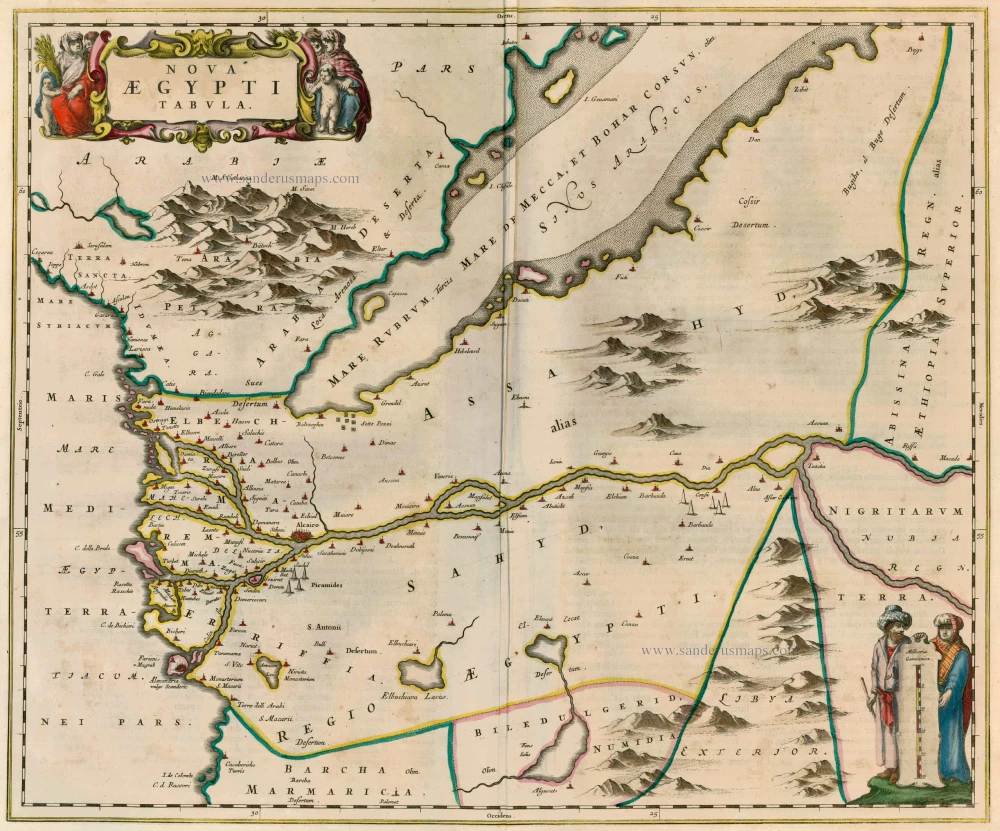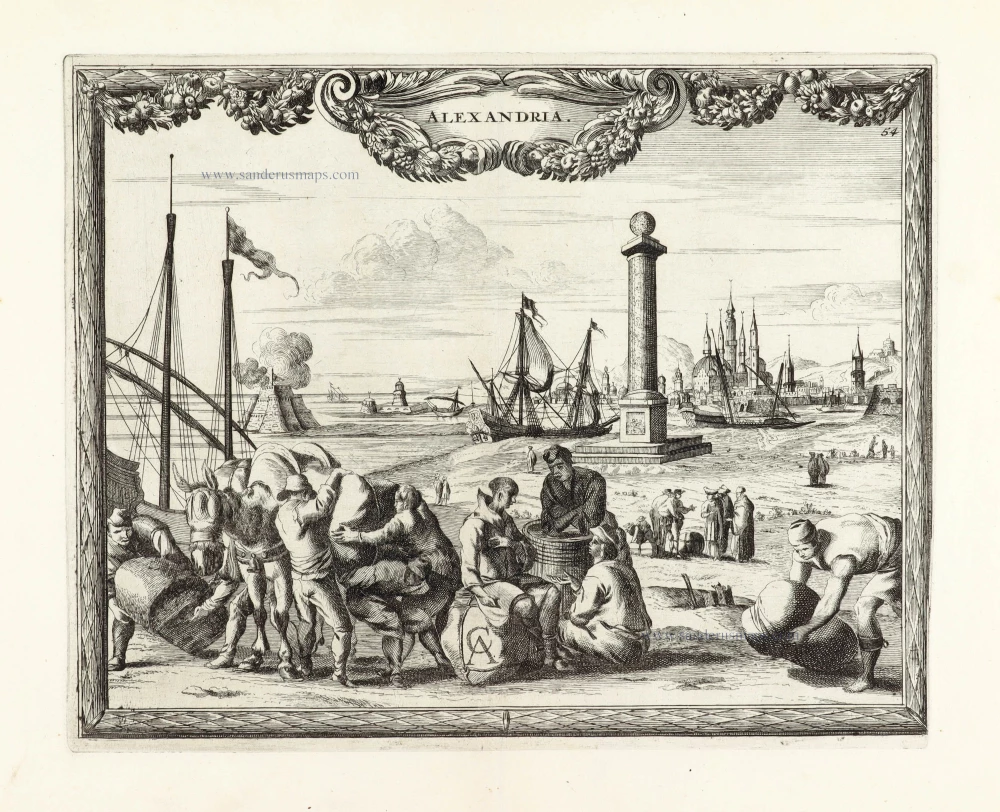Egypt - Alexandria by Georg Braun & Frans Hogenberg 1597
TRANSLATION OF CARTOUCHE TEXT: Alexandria, the ancient Egyptian centre of trade, was a huge town founded by Alexander the Great; it was built in 320 BC with walls, towers and fortifications; once magnificent and even today well fortified, but inside its walls full of ruins and rubble, it is comparable in size to Paris.
COMMENTARY BY BRAUN (on verso): "Alexandria is rectangular in shape and has four gates. The first led toward the Nile, the next to the south toward the lake, the third to the west toward the desert, and the fourth toward the Mediterranean, where the harbour is located. Toll keepers and common servants search travellers there down to their skin since duty must be paid not only on their wares but also on every last cent they carry."
Alexandria is depicted as a sprawling, formidably fortified town, crisscrossed by multiple arms of the river and where few buildings, but many ruins, stand. Alexandria was founded by Alexander the Great on the Nile Delta and, under the Ptolemaic Empire, was extended to become the capital of Egypt. In the 16th century, Alexandria was still used as a commercial port, but it lost its political and economic importance after its capture by the Arabs in AD 642. During its heyday, the city was renowned in particular for its culture and science: the library of Alexandria was the largest in the ancient world and was affiliated with the Musaeum, a celebrated school of philology. The lighthouse at Alexandria, the Pharos, one of the Seven Wonders of the Ancient World, is also identifiable on a peninsula to the left. Today, with 3.87 million residents, Alexandria is once again a major international commercial port due to its location on the Suez Canal. (Taschen)
Braun G. & Hogenberg F. and the Civitates Orbis Terrarum.
The Civitates Orbis Terrarum, also known as the 'Braun & Hogenberg', is a six-volume town atlas and the most excellent book of town views and plans ever published: 363 engravings, sometimes beautifully coloured. It was one of the best-selling works in the last quarter of the 16th century. Georg Braun, a skilled writer, wrote the text accompanying the plans and views on the verso. Many plates were engraved after the original drawings of a professional artist, Joris Hoefnagel (1542-1600). The first volume was published in Latin in 1572 and the sixth in 1617. Frans Hogenberg, a talented engraver, created the tables for volumes I through IV, and Simon van den Neuwel made those for volumes V and VI. Other contributors were cartographers Daniel Freese and Heinrich Rantzau, who provided valuable geographical information. Works by Jacob van Deventer, Sebastian Münster, and Johannes Stumpf were also used as references. Translations appeared in German and French, making the atlas accessible to a broader audience.
Since its original publication of volume 1 in 1572, the Civitates Orbis Terrarum has left an indelible mark on the history of cartography. Seven more editions followed the first volume in 1575, 1577, 1582, 1588, 1593, 1599, and 1612. Vol.2, initially released in 1575, saw subsequent editions in 1597 and 1612. The subsequent volumes, each a treasure trove of historical insights, graced the world in 1581, 1588, 1593, 1599, and 1606. The German translation of the first volume, a testament to its widespread appeal, debuted in 1574, followed by the French edition in 1575.
Several printers were involved: Theodor Graminaeus, Heinrich von Aich, Gottfried von Kempen, Johannis Sinniger, Bertram Buchholtz, and Peter von Brachel, all of whom worked in Cologne.
Georg Braun (1541-1622)
Georg Braun, the author of the text accompanying the plans and views in the Civitates Orbis Terrarum, was born in Cologne in 1541. After his studies in Cologne, he entered the Jesuit Order as a novice, indicating his commitment to learning and intellectual pursuits. In 1561, he obtained his bachelor's degree; in 1562, he received his Magister Artium, further demonstrating his academic achievements. Although he left the Jesuit Order, he continued his studies in theology, gaining a licentiate in theology. His theological background likely influenced the content and tone of the text in the Civitates Orbis Terrarum, adding a unique perspective to the work.
Frans Hogenberg (1535-1590)
Frans Hogenberg was a Flemish and German painter, engraver, and mapmaker. He was born in Mechelen as the son of Nicolaas Hogenberg.
By the end of the 1560s, Frans Hogenberg was employed upon Abraham Ortelius's Theatrum Orbis Terrarum, published in 1570; he is named an engraver of numerous maps. In 1568, he was banned from Antwerp by the Duke of Alva and travelled to London, where he stayed a few years before emigrating to Cologne. He immediately embarked on his two most important works, the Civitates, published in 1572 and the Geschichtsblätter, which appeared in several series from 1569 until about 1587.
Thanks to large-scale projects like the Geschichtsblätter and the Civitates, Hogenberg's social circumstances improved with each passing year. He died as a wealthy man in Cologne in 1590.
Alexandria, Vetustissimum Aegypti Emporium, Amplissima Civitas .Penon de Veles.
Item Number: 24010 Authenticity Guarantee
Category: Antique maps > Africa
Old, antique bird’s-eye view plan of Egypt - Alexandria by Georg Braun & Frans Hogenberg.
Title: Alexandria, Vetustissimum Aegypti Emporium, Amplissima Civitas .Penon de Veles.
Date of the first edition: 1575.
Date of this map: 1597.
Copper engraving, printed on paper.
Size (not including margins): 365 x 480mm (14.37 x 18.9 inches).
Verso: Latin text.
Condition: Uncoloured, excellent.
Condition Rating: A.
From: Civitates Orbis Terrarum, ... Part 2: De Praecipuis, Totius Universi Urbibus, Liber Secundus. Köln, Bertram Buchholz, 1597. (Van der Krogt 4, 41:1.2)
TRANSLATION OF CARTOUCHE TEXT: Alexandria, the ancient Egyptian centre of trade, was a huge town founded by Alexander the Great; it was built in 320 BC with walls, towers and fortifications; once magnificent and even today well fortified, but inside its walls full of ruins and rubble, it is comparable in size to Paris.
COMMENTARY BY BRAUN (on verso): "Alexandria is rectangular in shape and has four gates. The first led toward the Nile, the next to the south toward the lake, the third to the west toward the desert, and the fourth toward the Mediterranean, where the harbour is located. Toll keepers and common servants search travellers there down to their skin since duty must be paid not only on their wares but also on every last cent they carry."
Alexandria is depicted as a sprawling, formidably fortified town, crisscrossed by multiple arms of the river and where few buildings, but many ruins, stand. Alexandria was founded by Alexander the Great on the Nile Delta and, under the Ptolemaic Empire, was extended to become the capital of Egypt. In the 16th century, Alexandria was still used as a commercial port, but it lost its political and economic importance after its capture by the Arabs in AD 642. During its heyday, the city was renowned in particular for its culture and science: the library of Alexandria was the largest in the ancient world and was affiliated with the Musaeum, a celebrated school of philology. The lighthouse at Alexandria, the Pharos, one of the Seven Wonders of the Ancient World, is also identifiable on a peninsula to the left. Today, with 3.87 million residents, Alexandria is once again a major international commercial port due to its location on the Suez Canal. (Taschen)
Braun G. & Hogenberg F. and the Civitates Orbis Terrarum.
The Civitates Orbis Terrarum, also known as the 'Braun & Hogenberg', is a six-volume town atlas and the most excellent book of town views and plans ever published: 363 engravings, sometimes beautifully coloured. It was one of the best-selling works in the last quarter of the 16th century. Georg Braun, a skilled writer, wrote the text accompanying the plans and views on the verso. Many plates were engraved after the original drawings of a professional artist, Joris Hoefnagel (1542-1600). The first volume was published in Latin in 1572 and the sixth in 1617. Frans Hogenberg, a talented engraver, created the tables for volumes I through IV, and Simon van den Neuwel made those for volumes V and VI. Other contributors were cartographers Daniel Freese and Heinrich Rantzau, who provided valuable geographical information. Works by Jacob van Deventer, Sebastian Münster, and Johannes Stumpf were also used as references. Translations appeared in German and French, making the atlas accessible to a broader audience.
Since its original publication of volume 1 in 1572, the Civitates Orbis Terrarum has left an indelible mark on the history of cartography. Seven more editions followed the first volume in 1575, 1577, 1582, 1588, 1593, 1599, and 1612. Vol.2, initially released in 1575, saw subsequent editions in 1597 and 1612. The subsequent volumes, each a treasure trove of historical insights, graced the world in 1581, 1588, 1593, 1599, and 1606. The German translation of the first volume, a testament to its widespread appeal, debuted in 1574, followed by the French edition in 1575.
Several printers were involved: Theodor Graminaeus, Heinrich von Aich, Gottfried von Kempen, Johannis Sinniger, Bertram Buchholtz, and Peter von Brachel, all of whom worked in Cologne.
Georg Braun (1541-1622)
Georg Braun, the author of the text accompanying the plans and views in the Civitates Orbis Terrarum, was born in Cologne in 1541. After his studies in Cologne, he entered the Jesuit Order as a novice, indicating his commitment to learning and intellectual pursuits. In 1561, he obtained his bachelor's degree; in 1562, he received his Magister Artium, further demonstrating his academic achievements. Although he left the Jesuit Order, he continued his studies in theology, gaining a licentiate in theology. His theological background likely influenced the content and tone of the text in the Civitates Orbis Terrarum, adding a unique perspective to the work.
Frans Hogenberg (1535-1590)
Frans Hogenberg was a Flemish and German painter, engraver, and mapmaker. He was born in Mechelen as the son of Nicolaas Hogenberg.
By the end of the 1560s, Frans Hogenberg was employed upon Abraham Ortelius's Theatrum Orbis Terrarum, published in 1570; he is named an engraver of numerous maps. In 1568, he was banned from Antwerp by the Duke of Alva and travelled to London, where he stayed a few years before emigrating to Cologne. He immediately embarked on his two most important works, the Civitates, published in 1572 and the Geschichtsblätter, which appeared in several series from 1569 until about 1587.
Thanks to large-scale projects like the Geschichtsblätter and the Civitates, Hogenberg's social circumstances improved with each passing year. He died as a wealthy man in Cologne in 1590.















